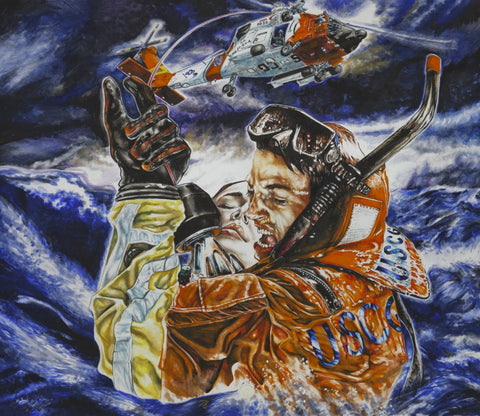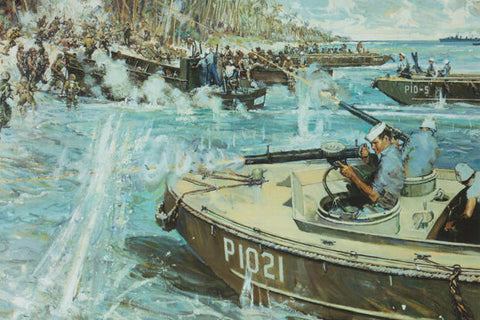
The U.S. Coast Guard celebrates 230 years of service to the nation August 4 and today, like most days, they will be busy impacting the lives of Americans through their missions.
Each day the Coast Guard investigates 45 search and rescue cases, saves 10 lives and more than $1.2 million in property, as well as seizing nearly 900 pounds of cocaine and more than 200 pounds of marijuana.
Yet because of its law enforcement and rescue missions, and the fact that it is a part of the Department of Homeland Security, the Coast Guard is often dismissed as a military service, and many incorrectly believe it is not a part of the U.S. military. While it is true that the Coast Guard is a part of the Department of Homeland Security and not the Department of Defense, it is officially a part of the U.S. military.
Title 14 U.S. Code states that “The Coast Guard as established January 28, 1915, shall be a military service and a branch of the armed forces of the United States at all times. The Coast Guard shall be a service in the Department of Homeland Security, except when operating as a service in the Navy.”
Title 14 U.S. Code also states: “Upon the declaration of war if Congress so directs in the declaration or when the President directs, the Coast Guard shall operate as a service in the Navy, and shall so continue until the President, by Executive order, transfers the Coast Guard back to the Department of Homeland Security.”
The Coast Guard’s beginning can be traced to August 1789, when Congress created the Lighthouse Establishment. According to the Coast Guard, the U.S. government “accepted title to, and joined jurisdiction over, the 12 lighthouses then in existence, and provided that ‘the necessary support, maintenance and repairs of all lighthouses, beacons, buoys and public piers erected, placed, or sunk before the passing of this act, at the entrance of, or within any bay, inlet, harbor, or port of the United States, for rendering the navigation thereof easy and safe, shall be defrayed out of the treasury of the United States.’ Prior to this time the lighthouses had been paid for, built and administered first by the colonies and then the states.”
A little less than a year later, on August 4, 1790, the U.S. Congress authorized the construction of 10 cutters known variously as the system of cutters, Revenue Service, and Revenue-Marine, it would officially be named the Revenue Cutter Service in 1863. The cutters were placed under the control of the Treasury Department to enforce federal tariff and trade laws and to prevent smuggling. August 4 became the official Coast Guard birthday.
In 1915 the service received its current name when the Revenue Cutter Service was merged with the Life-Saving Service, providing the nation with a maritime service dedicated to saving life at sea and enforcing the nation's maritime laws.
When the United States entered World War I, it sent the Coast Guard under the operational control of the U.S. Navy. In 1918, the Coast Guard cutter Tampa was attacked by a German submarine in Bristol Channel and the ship sank with all hands aboard; 111 Coast Guardsmen, four U.S. Navy sailors, and 16 passengers.
During World War II, the Coast Guard augmented the U.S. Navy and at Guadalcanal on Sept. 27, 1942, U.S. Coast Guard Signalman 1st Class Douglas Munro earned the Medal of Honor posthumously. He is the Coast Guard’s only recipient of the Medal of Honor.

Approximately 240,000 men and women served in the Coast Guard during WWII. More than 600 died in combat and almost 2,000 Coast Guardsmen were decorated for their service, six received the Navy Cross. The Coast Guard returned to the operational control of the Treasury Department in January 1946.
During the Korean War, the Coast Guard helped evacuate the Korean peninsula during the first North Korean attack. The Coast Guard also established several long-range navigation stations in Korea and Japan that assisted United Nations forces.
In 1967, the Coast Guard was transferred to the Department of Transportation and the Coast Guard was mobilized again. President Lyndon B. Johnson deployed Coast Guard vessels to the Vietnam War, and they conducted interdiction and combat missions. The Coast Guard also provided port security, Explosives Loading Detachments, installation and maintenance of aids-to-navigation, established long range navigation stations in both Vietnam and Thailand and Coast Guard pilots conducted search and rescue missions with the U.S. Air Force.
Roughly 8,000 Coast Guard personnel served in Vietnam, supporting both combat and traditional service missions. Seven members of the Coast Guard died in the Vietnam War and approximately 60 were wounded.
In August 1990, the Coast Guard was sent overseas for Operation Desert Shield to support the enforcement of United Nations sanctions. Later that month 550 members of the Coast Guard Reserve were called to active duty in support of Operation Desert Shield. This was the first involuntary overseas mobilization of the Coast Guard Reserve. By war’s end, more than 900 Coast Guard reservists would be called up.
In January 1991, the Coast Guard took 23 prisoners while patrolling oil platforms in the Persian Gulf and during Desert Storm Coast Guard aircraft flew environmental protection missions in the region when Iraq intentionally spilled oil into the ocean.
In 1999, the Coast Guard deployed to the Adriatic Sea in support of Operation Allied Force and Operation Noble Anvil. The Coast Guard provided surface surveillance and search and rescue response and force protection.
After the 9/11 attacks in 2001, the Coast Guard was transferred from the Department of Transportation to the Department of Homeland Security in 2003.
During Operation Iraqi Freedom and Operation Enduring Freedom, the Coast Guard deployed cutters and primarily assisted in force protection and search and seizures of suspected smugglers in Iraqi and international waters. Coast Guard military advisers trained and mentored the Iraqi Navy and they provided technical assistance to Iraqi officials on the implementation of international port security standards and requirements.
The Coast Guard sent Redeployment Assistance and Inspection Detachment teams to both Iraq and Afghanistan. The teams assisted the units of other services with the proper declaration, classification, labeling and packaging of container shipments as well as the inspection of containers for structural integrity to ensure each one is seaworthy to cut down on potential shipping problems.
In April 2004, Petty Officer 3rd Class Nathan B. Bruckenthal, became the first Coast Guardsman to die in a combat zone since the Vietnam War. He was killed in a suicide boat attack on a Basra oil terminal off the coast of Iraq performing maritime security.
At the height its involvement in Afghanistan and Iraq, the Coast Guard deployed more than 1,200 men and women, including about 500 reservists, 11 ships, four port-security units, law enforcement detachments, and other specialized teams and support staff in order to perform a wide range of operations in Iraq, Afghanistan, Kuwait, and the Persian Gulf.
When it is not at war, the Coast Guard is the primary federal agency responsible for maritime safety, security, and environmental stewardship in U.S. ports and waterways. The Coast Guard protects and defends more than 100,000 miles of U.S. coastline and inland waterways, and safeguards an economic zone encompassing 4.5 million square miles stretching from north of the Arctic Circle to south of the equator, from Puerto Rico to Guam, encompassing nine time zones.
In addition to its role as an Armed Service, the Coast Guard is a first responder and humanitarian service that provides aid to people in distress or impacted by disasters whether at sea or ashore. The Coast Guard is a member of the intelligence community and is a law enforcement and regulatory agency with broad legal authorities associated with maritime transportation, hazardous materials shipping, bridge administration, oil spill response, pilotage, and vessel construction and operation.
“Recently, the Coast Guard has been integral in overseeing the disembarkation of 250,000 from cruise ships to reduce risks under COVID-19 emergency,” U.S. Coast Guard Spokesperson Lt. Commander Brittany Panetta said. The outbreak of COVID-19 on cruise ships triggered the Coast Guard to enable 31 life-saving medevacs.
War and maritime service aside, two Coast Guard personnel have gone on to become NASA shuttle astronauts, Bruce Melnick and Daniel Burbank. Also, several Coast Guard members attended U.S. Navy SEAL training under a 2010 agreement between the Navy and Coast Guard. The program has since been discontinued.
As they celebrate their birthday, there are more than 42,000 members currently serving in the U.S. Coast Guard in a fleet of 243 Cutters, 201 fixed and rotary-wing aircraft, and more than 1,650 boats.